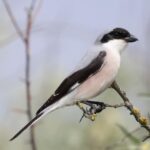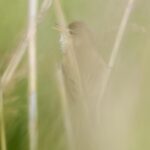A Private Tour today in North Norfolk. It was to be a relaxed day of birding and photography along the North Norfolk coast. The weather was kind to us – after a cloudy start, it brightened up late morning and was lovely and sunny in the afternoon. It was so warm, it almost felt like spring!
As we made our way east along the coast road, we spotted a Barn Owl hunting the verge ahead of us. There were trees either side beyond, so it turned and came back towards us, crossing the road right in front before disappearing over the hedge the other side. A pair of Grey Partridges flew across the road too.
Our first destination for the morning was Cley. As we parked at Walsey Hills and walked back to the East Bank, several small flocks of Brent Geese flew east and appeared to head inland.
The grazing marshes from the East Bank looked quiet at first, but on closer inspection we could see quite a few ducks. A flock of Wigeon were just in the process of walking back out from the Serpentine onto the grass to graze. We watched them all, walking in the same direction, heads down feeding. Small parties of Teal were flying round, landing on the pools. Several Gadwall were swimming on the Serpentine. Six Shelduck were on the island on Pope’s Pool then flew across to the grass. A Grey Heron was in the ditch at the back.
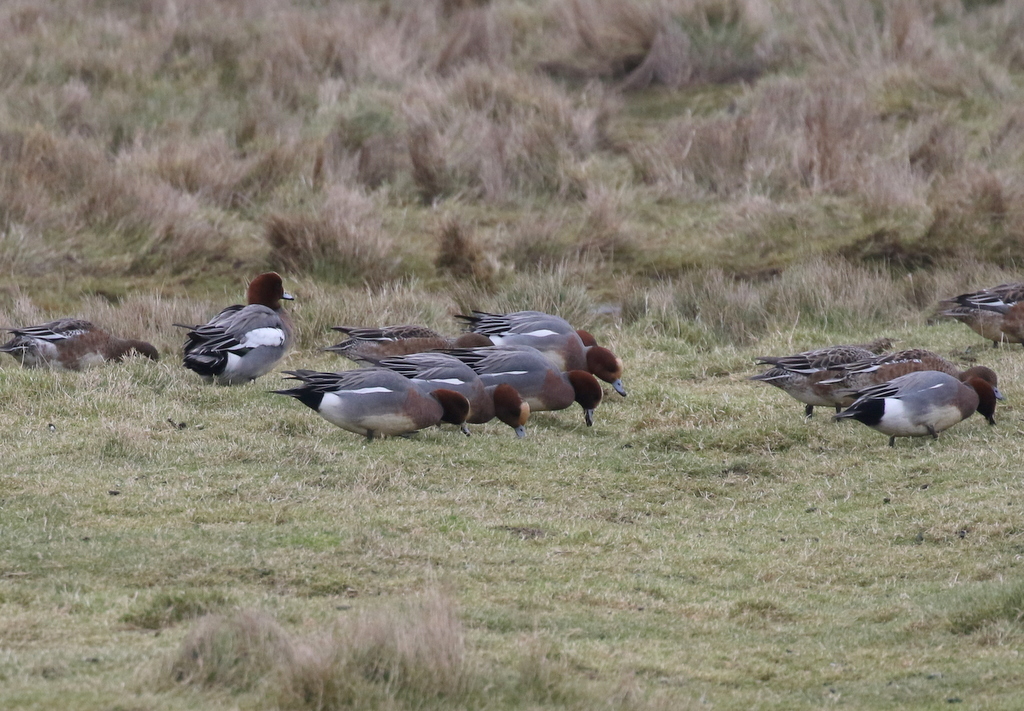
Three Marsh Harriers circled up over the reeds the other side. One of them landed in a bush, where we could get it in the scope. Another did a nice fly past, one of last year’s juveniles, dark chocolate brown with a pale head. From up by the main drain, we could hear Bearded Tits calling but despite scanning the edges of the reeds we couldn’t see them. They were presumably keeping well down in the reeds as usual.
Arnold’s Marsh had a good number of waders on it today, so we stopped in the shelter for a closer look. There were quite a few Dunlin scattered around the shallow water, and two Ringed Plover with them. A Grey Plover and two Turnstones were feeding on one of the gravel spits on one side. There were plenty of Redshanks and a few Curlews too. A Little Egret was walking around on the brackish pools just behind the shelter.
Over on the beach by sea pool, we could just make out a seal carcass on the shingle. The Glaucous Gull has been feeding on it recently but was not there today – we could see a young Great Black-backed Gull there instead. From the other side of the shelter, we could see another seal carcass on the beach over towards North Scrape but we couldn’t see the Glaucous Gull at that one either. We spotted a couple of the locals coming back from the beach and they told us that the Glaucous Gull was currently on North Scrape so we decided to walk over there to try to see it.
Before we got to the screen where the hide used to be, we looked across to North Scrape and could see the Glaucous Gull standing in the water on the edge of one of the islands. We got the scope on it and watched it, busy preening. Presumably, after a messy morning feeding on one of the seals it had decided it needed a wash and a tidy up!
Looking out to the sea behind us, we spotted a small flock of Common Scoter flying past. They landed on the sea away to west in the distance. A couple of Red-throated Divers flew across too.
Continuing on to the screen overlooking North Scrape, we had a much closer view of the Glaucous Gull. It was a juvenile – pale biscuit coloured, with subtle slightly darker markings on the wings and back and very pale whitish wing tips. The heavy bill, perfect for tearing into seal carcasses, was pink with a clearly marked black tip. It has been here for over a month now and seems to be finding plenty of food.
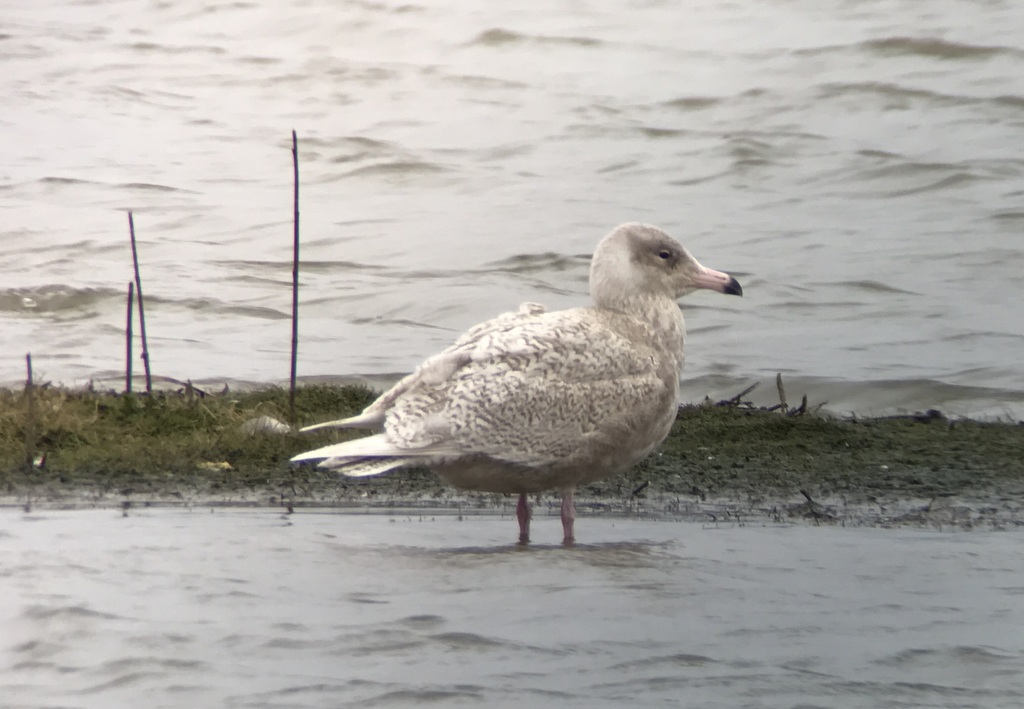
Otherwise, there were quite a few ducks on North Scrape. Most notably, there were at least 50 Pintail. We got two smart drakes, which had walked out onto one of the islands to preen, in the scope for a closer look. Out of the water, we could see their long pin-shaped tail feathers. Several Shoveler were asleep down towards the front and more Brent Geese flew in and landed out on the water.
There has been a flock of Snow Buntings along the beach here, so when we heard one calling we assumed there was a flock coming. Instead, there was just one Snow Bunting accompanying a flock of Goldfinches. The latter dropped down to feed out on the beach, while the Snow Bunting carried on.
As walked on west towards the beach car park at Cley, we found more Snow Buntings in the weedy vegetation at the top of the shingle. The Goldfinches joined them, but the latter were very jumpy and kept flying up, taking the Snow Buntings with them. Eventually, the Snow Buntings settled down to feed in the vegetation on their own and we could get a better look at them. There were a few Skylarks hiding in the grass here too.
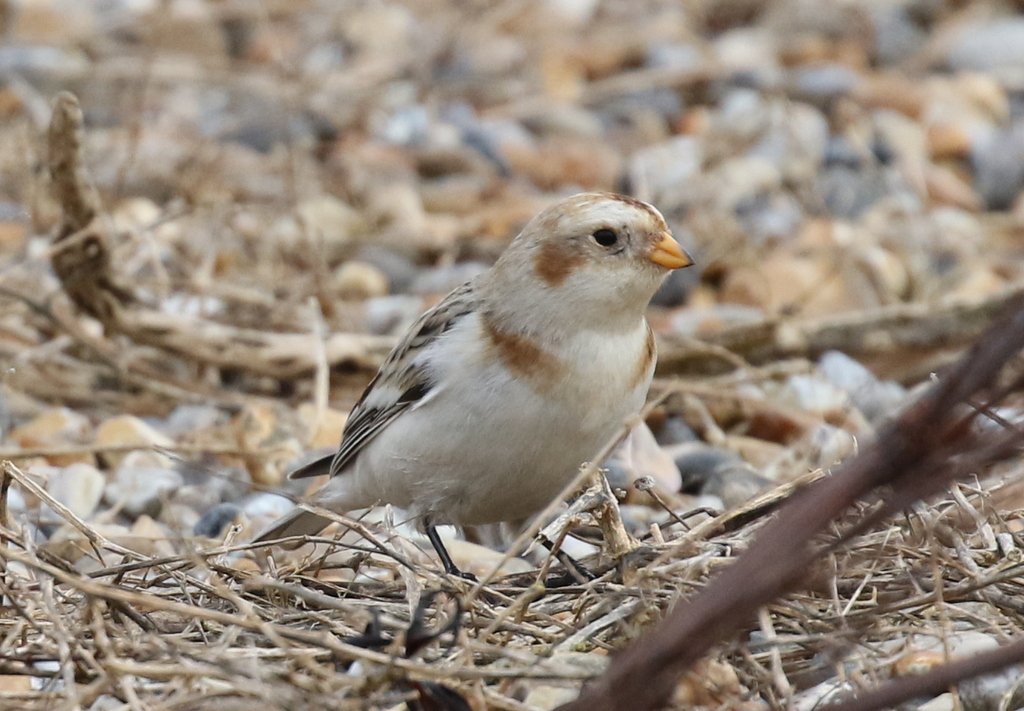
When we heard Pink-footed Geese calling, we looked across to see a huge flock dropping down onto Blakeney Freshes beyond the West Bank. The group stopped to try to photograph the Snow Buntings, and then walked on to the car park, where the van came round to pick them up.
From Cley, we drove back west. From the main road, we could see a flock of Brent Geese feeding in winter wheat east of Wells. There has been a Black Brant at times with the geese here, but there was nowhere to stop on this stretch. When we found somewhere to pull in and let the cars behind us pass, the geese were hidden from view in a dip in the field from here. There were a few more Brent Geese out on the saltmarsh in the middle of the harbour at Wells, but none on the old pitch and putt course today.
After a busy morning a break was called for now, so we stopped for an early lunch at the Victoria in Holkham. Then after lunch, we drove up to the top of Lady Anne’s Drive to park. The wardens were working out on the fields east of the Drive, so there wasn’t much out that side. There were lots of geese and Wigeon on the grazing marshes to the west though. Three Common Buzzards circled over, and all the ducks and Lapwing flushed and whirled round.
A small group of Pink-footed Geese were feeding close to the fence, so we stopped and got the scope on them for a closer look. A couple of Greylags were with them, giving us a nice comparison between the two species alongside each other. A few Brent Geese flew in and landed just the other side of the drive, but a Brown Hare which had probably been disturbed by the wardens ran across and flushed them before they could settle.
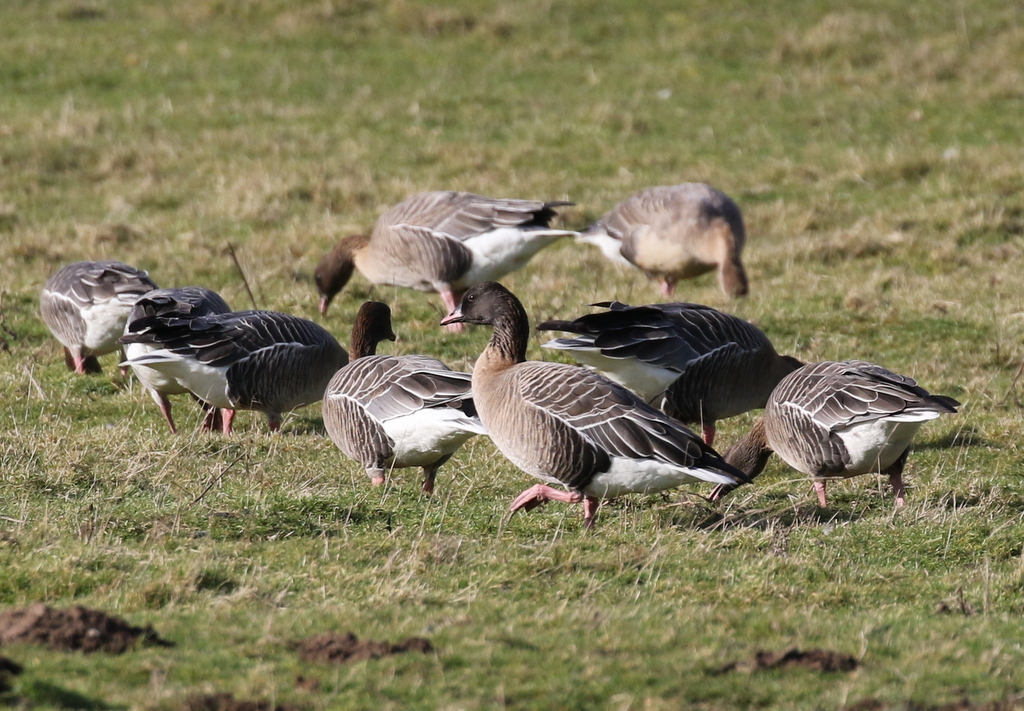
We made our way through the pines and out onto the saltmarsh, turning east along the path below the dunes. When we saw movement in the low vegetation we stopped for a look. There were lots of Rock Pipits, at least ten, feeding on the saltmarsh close to the path. We had really good views of them here, their underparts heavily blotched with dark and oily brown above, with a noticeable pale supercilium. These are Scandinavian Rock Pipits here for the winter. A flock of Linnets flew up from the back of the saltmarsh and whirled round.
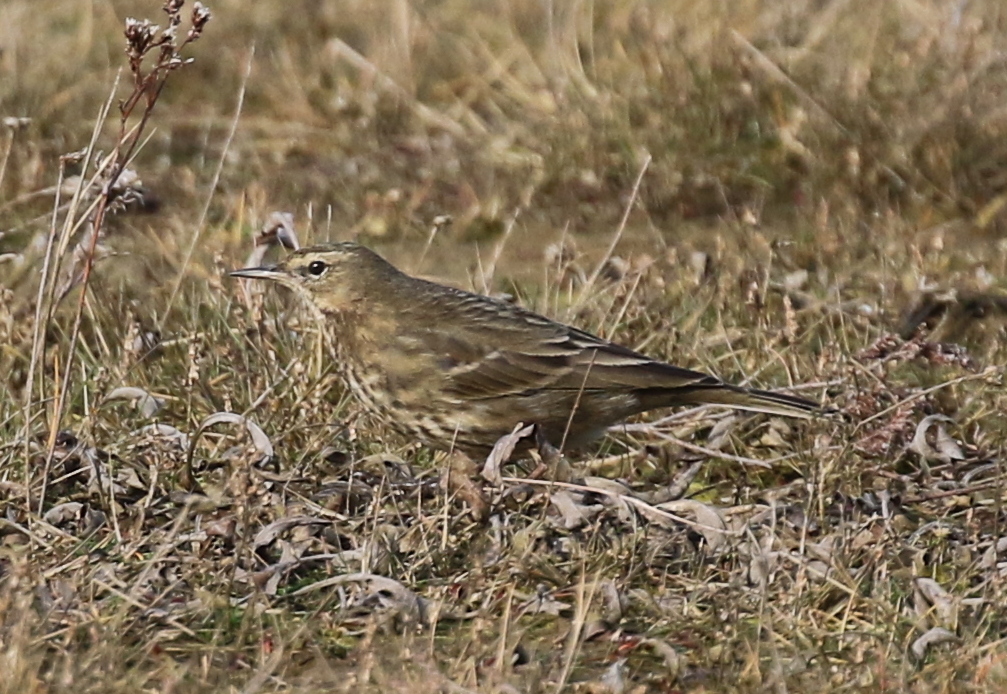
A small group of people had been watching the Shorelarks but were leaving as we arrived. They pointed out where they were, and when we got there it didn’t take us long to relocate them. They were a bit too distant for photographs, but we had a great view through the scope of their yellow faces and black masks. We could only see five at first, so we scanned around for the rest, hoping we might find some closer to the path. Unfortunately, when we found them, they were even further back. Still, Shorelarks are great birds to see and we stopped to admire them for a bit.
The Dartford Warbler is still lingering in the dunes here, so we decided to go to look for that and see if the Shorelarks might come closer later. It didn’t take long to find the Stonechat here, perched up on a curl of bramble stem above the sea buckthorn. True to form, while we were admiring the Stonechat, the Dartford Warbler flew in. It landed right on the top of the bushes for a couple of seconds, before dropping down into cover.
We continued watching the Stonechat, and after a while we saw the Dartford Warbler come up again in the sea buckthorn nearby. It didn’t come right out again, but we could see it creeping around in the branches, feeding on buckthorn berries.
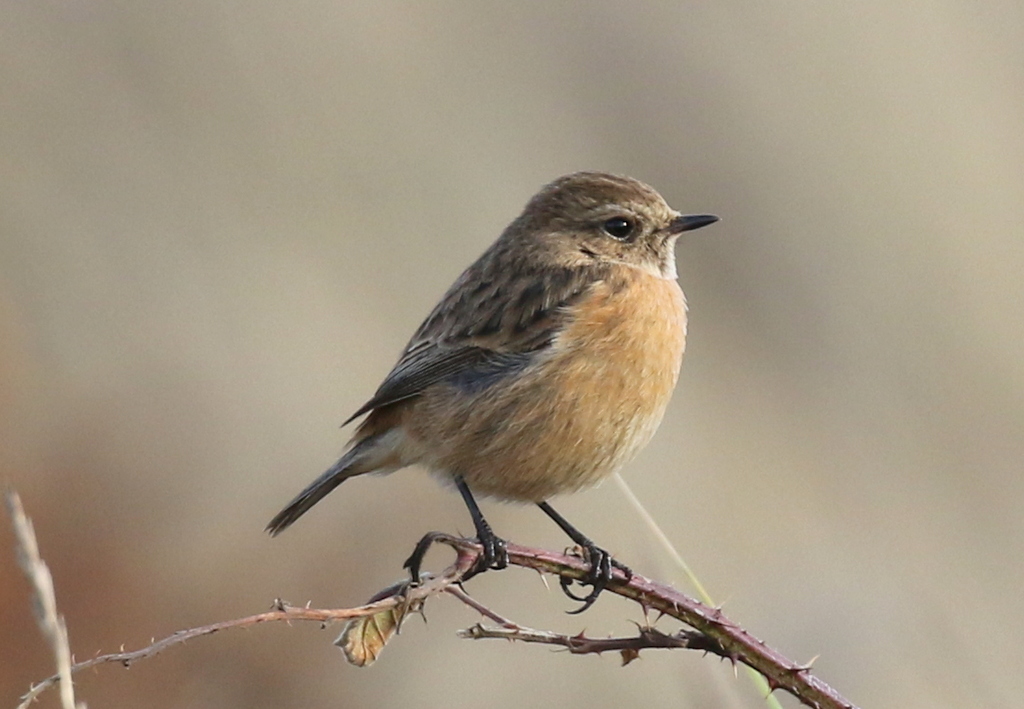
The Snow Buntings were in the cordoned off area of saltmarsh, but they were hiding in the taller vegetation today. At one point they flew round, at least 40 of them in the flock today, flashing the white in their wings, but landed in cover again. Having enjoyed great views of the Snow Buntings at Cley earlier, we didn’t stop to see them here.
When two people walked right across the middle of the saltmarsh, not surprisingly they flushed the Shorelarks. We heard them calling and turned to see them flying round. We could now see how many there were, still around 25 in the flock, which is the number that have been here on and off for most of the winter.
Most of the Shorelarks flew further back across the saltmarsh and landed out in the really thick vegetation where they would be impossible to see from the path. But three had obviously been separated from the rest and flew round again. We watched one land by the path back towards the Gap, where we had stopped to watch the Rock Pipits earlier. So we walked back and found two Shorelarks now feeding with the pipits.
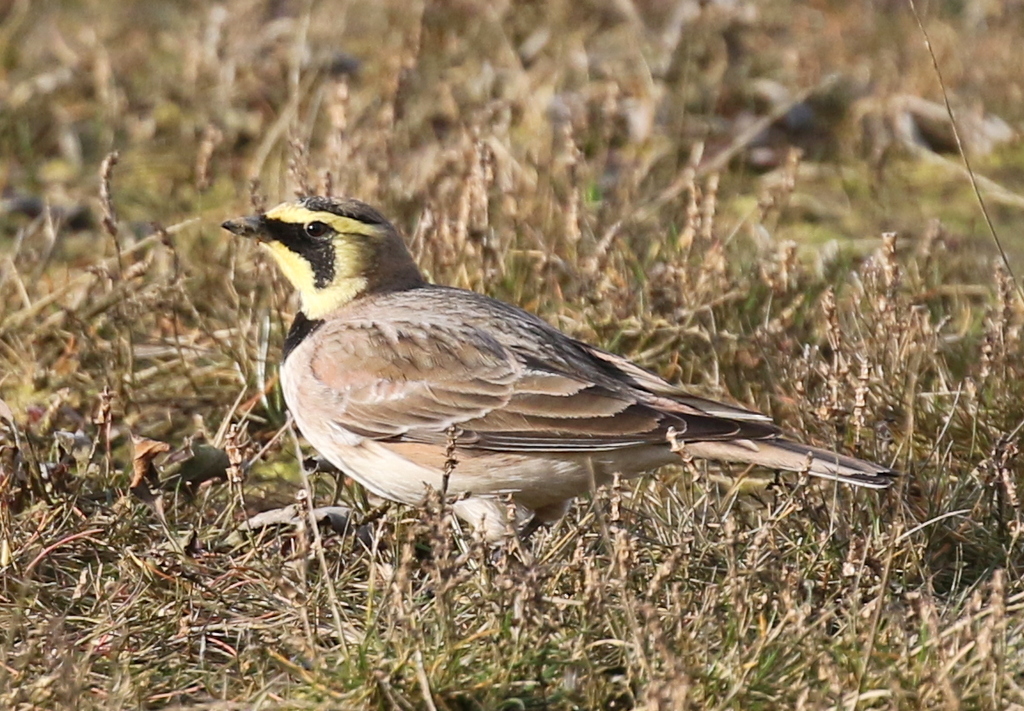
Approaching slowly on the path, we were able to get quite close to the Shorelarks and they gradually worked their way closer still, so we were able to enjoy great views of them and finally get some better photos. Their yellow faces positively shone in the low afternoon sunlight.
Eventually, we had to tear ourselves away and walked back to Lady Anne’s Drive. As we drove on west, we had a quick look in at Brancaster Staithe. It was low tide now and there were a few waders scattered around. A small group of Oystercatchers was roosting down on the edge of the water, a Grey Plover was picking around on the shore in front, and several Bar-tailed Godwits were feeding on the exposed sandbar beyond.
Titchwell was our final destination for the day. We had a walk round the trails to look for Woodcock first. As we passed the Visitor Centre, there were not many birds on the feeders this afternoon. There was no sign of the regular Woodcock on Fen Trail, but with some helpful directions we were able to quickly locate the one on Meadow Trail. It was very well hidden, below a tangle of branches in the sallows. It took a bit of time, but eventually we found an angle through the scope where we could see its eye staring back at us.
Walking quietly along the main path back towards the Visitor Centre, scanning carefully we found a Water Rail in the ditch. While we were watching it, a second one walked into view along the ditch nearby. One was noticeably bulkier than the other, presumably a male and female. They worked their way quite quickly back along the ditch, not exactly together but not far apart, and the smaller of the two came out slightly more into the open. Then we lost sight of them and they had obviously turned back and disappeared into cover.

There were some Long-tailed Tits in the trees above the ditch and when they started alarm calling, we realised there must be a raptor about. We couldn’t initially see it where we were in the trees, but a Sparrowhawk flew out over the grazing meadow and we watched it land on a post in the distance.
Further out along the path, we could hear a Cetti’s Warbler calling in the vegetation right by the path, but it remained typically elusive. A few Marsh Harriers were already in, circling over the back of the reeds or perched in the bushes.
As we walked out to the Freshmarsh, the first thing we noticed were the Avocets, 23 of them today. This is the most we’ve seen this year, with only 2-3 in recent weeks, suggesting they are starting to return to the coast already for the summer. They were flushed by a Marsh Harrier and flew round, flashing black and white. There were lots of Lapwings too, which landed back in the fenced off island, along with a small group of Golden Plover.
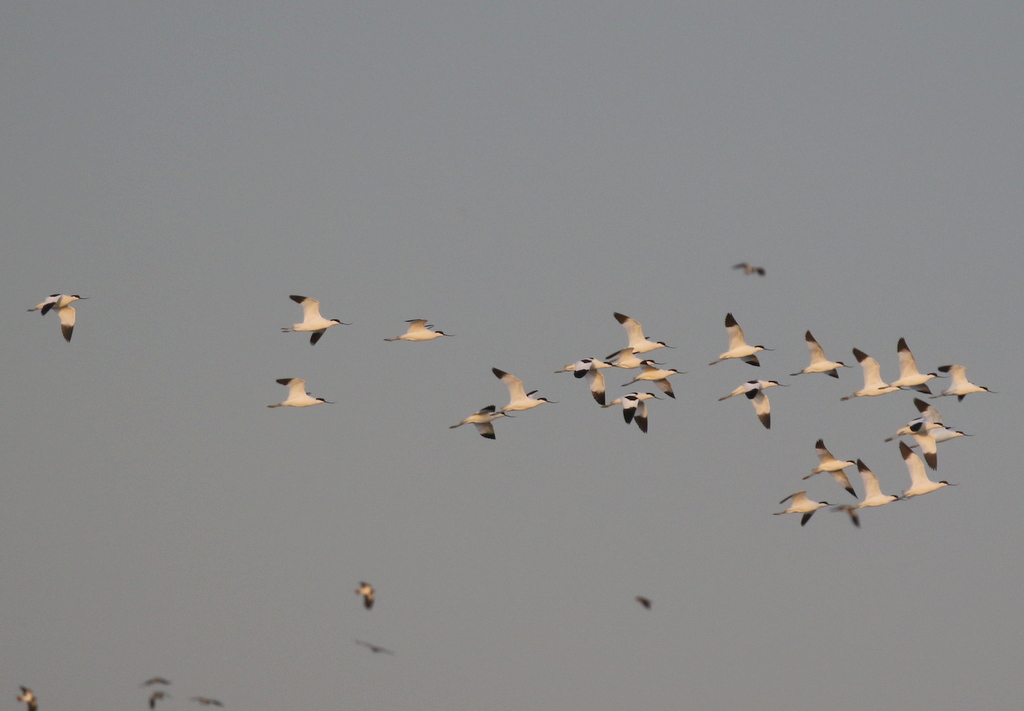
There were a few gulls dropping in to bathe, but otherwise with the water level on the Freshmarsh high for the winter, there were just a few ducks and geese. Unfortunately the light was starting to go now, particularly in the lee of the bank, but we watched a little group of Teal displaying on the water below us.
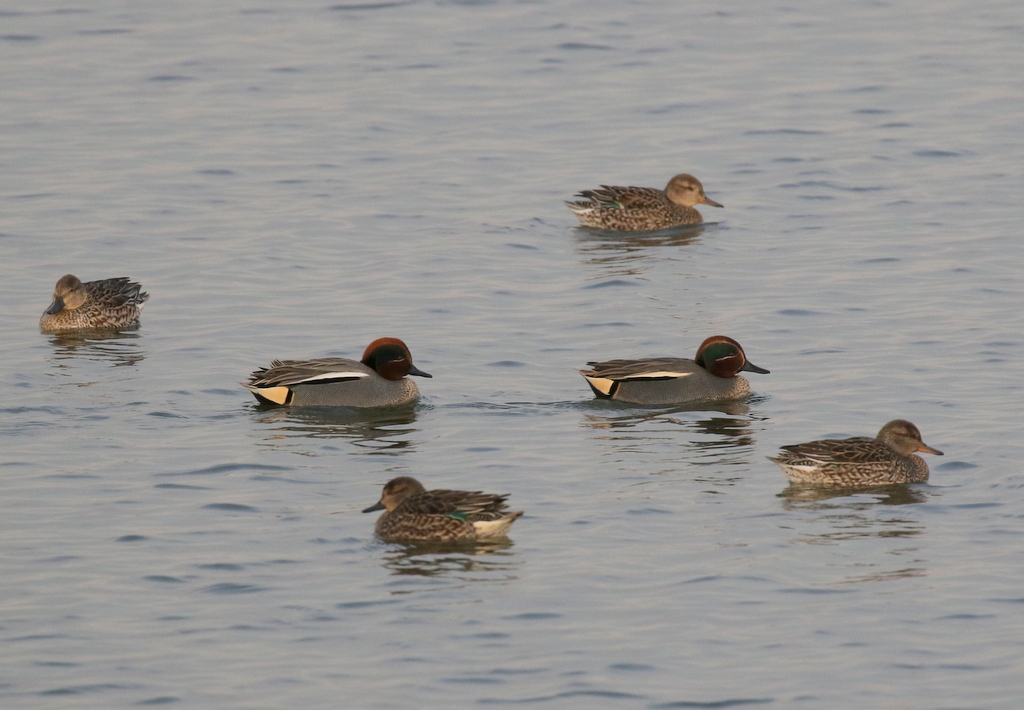
There were more Marsh Harriers coming in all the time, to join the increasing number gathered over the back of the reedbed. We turned to see a harrier flying straight towards us low over the saltmarsh behind and realised it was a Hen Harrier. It was quite close when it turned and flashed the white square at the base of its tail. It worked its way north over the saltmarsh close to the path, flushing lots of pipits from the vegetation. Some last minute hunting before heading into roost.
The Hen Harrier was a nice way to end, and it was getting late now, so we started to walk back. As we looked out over the reedbed one last time, we could see loads of Marsh Harriers up now all together. A quick count totalled thirty in view at once – quite a sight!
There was one last bird to add to the list. On our drive back, we noticed a small bird perched on the corner of a barn, silhouetted against the last of the light. A Little Owl, coming out just as we were finishing for the day.
